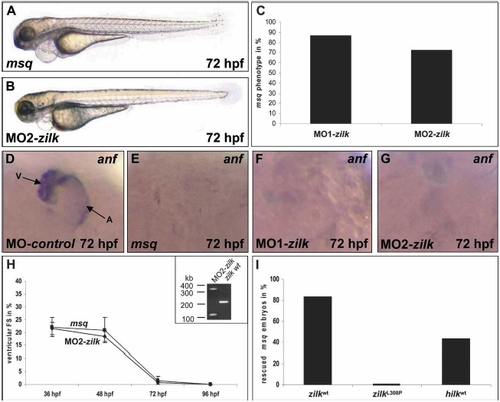
Antisense oligonucleotide-mediated knockdown of zilk phenocopies the msq mutant heart phenotype, whereas ectopic expression of wild-type ILK suppresses cardiac dysfunction in msq mutants. (A–H) Inhibition of zilk function by morpholino-modified antisense oligonucleotide injection phenocopies the msq mutant phenotype. MO2-zilk injected embryos (B) are indistinguishable from msq mutant embryos (A) and display severe impairment of ventricular contractility (H). (C) Eighty-seven percent of MO1-zilk-injected, and 72.1% of MO2-zilk-injected wild-type embryos display the msq mutant phenotype at 72 hpf. (D–G) Similar to the situation in msq mutant hearts (E), injection of either MO1-zilk (F) or MO2-zilk (G) leads to reduced zanf RNA levels in the heart. (D) In contrast, injection of MO-control has no effect on zanf expression. Atrium (A) and ventricle (V) are indicated. (H) Ventricular fractional shortening (FS) of MO2-zilk-injected and msq mutant embryos. The effect of MO2-zilk on mRNA splicing is shown in the inset. Injection of MO2-zilk results in abnormal splice products of 380 bp (integration of intron 4) and 125 bp (skipping of exon 4), predicted to lead to premature termination of translation of zilk. (I) Ectopic expression of wild-type ilk RNA from either zebrafish (zilk wt) or human (hilk wt) can rescue the heart phenotype of a significant proportion of msq mutant embryos, whereas injection of msq mutant RNA (zilk L308P) has no effect.
|

